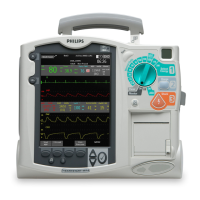Symptoms 20 Troubleshooting
263
CO
2
Calibration Overdue
INOP.
The CO
2
module should be
calibrated once a year or after 4,000
operating hours.
Do not use the CO
2
monitoring capabilities and call
for service to calibrate the CO
2
module. If CO
2
monitoring is essential to patient care, take the device
out of use.
CO
2
Check Exhaust INOP. When CO
2
is turned on, the
exhaust tube is blocked to the
extent that a measurement sample
cannot be taken.
Make sure the exhaust tubing is not kinked and is free
of blockages. If necessary, replace the tubing.
CO
2
Equip Malfunction INOP CO
2
hardware failure. Do not use the CO
2
monitoring capabilities and call
for service of the CO
2
module. If CO
2
monitoring is
essential to patient care, take the device out of use.
CO
2
Service Required INOP. The CO
2
module has reached its
end of life, defined as 15,000
operating hours.
Do not use the CO
2
monitoring capabilities and call
for service of the CO
2
module. If CO
2
monitoring is
essential to patient care, take the device out of use.
Table 6 8 CO
2
Monitoring Problems (Continued)
Symptom Possible Cause Possible Solution
Table 69 Defibrillation and Pacing Problems
Symptom Possible Cause Possible Solution
Analyzing Stopped
, or
Cannot Analyze ECG message
in AED Mode.
Excessive patient movement.
Radio or electrical sources are
interfering with ECG analysis.
Minimize patient movement. If the patient is being
transported, stop if necessary.
Remove possible sources of interference from the area.
Charge Button Failure INOP During an Operational Check,
when the Charge button was
pressed, there was no response.
Remove the device from use and call for service.
Defib Disarmed message.
The Shock button was not
pressed within the time period
specified in the Time to Auto
Disarm Configuration setting.
Therapy cable not attached. Pads/
paddles connection compromised.
No action required. If desired, charge the device and
press the Shock button.
Make sure the therapy cable is connected and the
pads/paddles are making proper contact with the
patient.
Maximum Energy 50J message. Attempted delivery of greater than
50J using internal paddles.
Only energies up to 50J are available for internal
defibrillation. Select a lower energy.
No Shock Delivered, Replace
Pads Now
message.
Faulty pads or poor pads
application to patient. (Low
impedance.)
Make sure pads are applied properly. If the problem
persists, replace the pads.
No Shock Delivered, Press
Pads Firmly
message.
Poor pads contact with the patient.
(High impedance.)
Make sure pads are applied properly. Firmly press pads
on the patient’s chest.
No Shock Delivered, Low/High
Impedance
message.
Poor paddles contact with patient
skin.
Paddles failure.
Make sure paddles are making adequate contact with
the patient’s skin. If the problem persists, replace the
paddles.
Pacer Equip Malfunction
INOP.
Pacing hardware failure. Call for service. If pacing functionality is essential to
patient care, take the device out of use.

